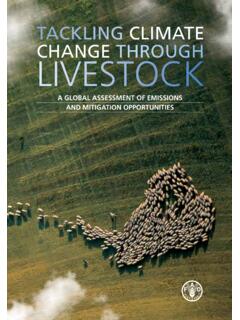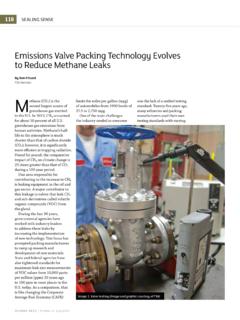Transcription of Livestock solutions for climate change - Home | Food and ...
1 Livestock solutions for climate changeLivestock solutions for climate changeLivestock are key to food security. Meat, milk and eggs provide 34% of the protein consumed globally as well as essential micro-nutrients such as vitamin B12, A, iron, zinc, calcium and ribofla-vin. But their contribution to food security and nutrition goes well beyond that, and includes a range of other goods and services, such as animal manure and traction. Hundreds of millions of vul-nerable people rely on Livestock in a changing climate , because of animals ability to adapt to marginal conditions and withstand climate shocks.
2 Livestock products are responsible for more greenhouse gases emissions than most other food sources. emissions are caused by feed production, enteric fermentation, animal waste and land-use change . Livestock supply chains account for GT CO2, equivalent to of global anthropogenic greenhouse gas emissions . Cattle (beef, milk) are responsible for about two-thirds of that total, largely due to methane emissions resulting from rumen fermen-tation. Enteric methane emissions represent 30% of global methane emissions .
3 Because methane is a short-lived climate pollutant, reducing emissions of enteric methane can help mitigate climate change , within our life carbon Livestock production is possible. But action must be much more decisive, as the Livestock sector is growing rapidly. Fueled by human population growth, higher incomes and urban-ization, demand for meat, milk and eggs in low- and middle-in-come countries is rising. There is considerable scope for reducing emissions and creating off-sets. The political will to do so has been expressed.
4 Ninety-two developing countries have included Livestock in their Nationally Determined Contributions (NDCs) under the Paris climate Agreement. To move forward, we need effective policies, strong institutions and the application of advanced proposes the following three ways to substantially reduce emissions from Livestock production: productivity improvements that reduce emission intensities; carbon sequestration through improved pasture management better Livestock integration in the circular bioeconomy.
5 These solutions can be combined and they also contribute to increase resilience to climate could also be reduced by targeting the demand for meat and other Livestock products where consumption is too , CO2 APPLIED & DEPOSITED MANURE, N2O FERTILIZER & CROP RESIDUES, N2O LUC - SOY & PALM, CO2 LUC - PASTURE EXPANSION, CO2 FEED - RICE, CH4 MANURE MANAGEMENT N2 OMANURE MANAGEMENT CH4 POST FARMGATE, CO2 INDIRECT ENERGY USE, CO2 ENTERIC FERMENTATION CH4 Global Livestock GHG emissions by sourceSource: GLEAM , reference year 2010, 1 Productivity improvements to reduce emission intensitiesEmission intensities are emissions expressed per kg of milk, meat or egg.
6 They vary a lot among producers in the same area, indi-cating considerable scope for improvement. FAO estimates that available improved husbandry practices can reduce emissions by 20 to 30%, across all production systems. Helping farmers to increase the productivity of Livestock is a mean to improve rural livelihoods and food security. It also supports better resilience to climate and Nutrition: Improving feed quality can be achieved through improved grassland management, improved pasture species ( grass and legumes mix), forage mix, feed processing ( chopping, urea treatment) and strategic use of supplements, preferably locally available.
7 Animal Health and Husbandry: Improving reproductive efficiency and extending the reproductive life of the animal will improve lifetime performance per animal and reduce GHG emission inten-sities. Reducing the incidence and impact of diseases, parasites and insect burdens will result in higher productivity and efficiency with lower losses and less unproductive animals that emit GHG. Animal Genetic Resources and Breeding: Breeding is key to increasing productivity by improving traits such as live-weight gain and milk yield or fertility.
8 It can also improve adaption of Livestock to changing environments, resistance to stress or shocks and diseases Well planned breeding programmes and conservation of animal genetic diversity can ensure farmers have access to the best animals in each 020030040050010034287 CATTLE MILK200030040050010055 PORK200030040050010035 CHICKEN EGGSKG CO2- PROTEIN-190% OF PRODUCTION50% OF PRODUCTIONAVERAGEG lobal Livestock GHG emissions by WITH CONCENTRATEESTABLISHMENT OF FODDER GRASSES AND LEGUMESFEED CONSERVATION (SILAGE)
9 DEWORMINGCONTROL OF EASTCOAST FEVERARTIFICIAL INSEMINATIONFAO is working with scientists, policy makers, industry and farmer organizations to identify and utilize existing low-cost technologies to improve the productivity in ruminant systems in Kenya and 12 other countries. These interventions will improve farmers livelihoods, lead to more nutritious and affordable food and generate employment and benefits to both rural and urban communities while also offering climate benefits. Example. Reducing enteric methane for improving food security and livelihoods in 13 countriesSource.
10 GLEAM , reference year 2010, 2 Carbon sequestrationPermanent pastures and meadows cover about billion ha, one quarter of the Earth s land area and 68% of the global agricultural the origin of agriculture, 10 000 years ago, people have domesticated and kept Livestock for their capacity to turn marginal resources into high value food, produce manure for fertilization, generate fibre and leather, and provide essential services, such as animal has a number of ecological functions and roles, including biomass removal that fosters regrowth by preventing accumulation of dead material, prevention of wild fires, regulation of hydrology and water quality by producing diverse landscapes, conservation of rich grasslands biodiversity and pollinators, dis-persal of seeds through ingestion and release in dung, but also of organic matter and nutrients.



















